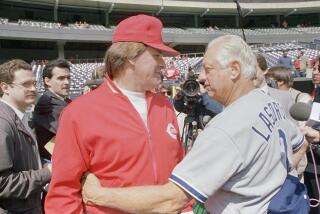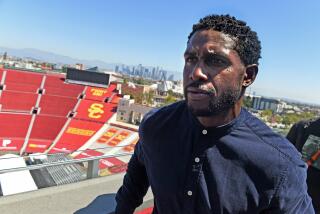Running Commentary From a Heisman Winner
- Share via
The two images and accompanying thoughts are stuck in my mind, snapshots from Heisman Trophy-winning seasons spaced 10 years apart.
One was a vision of Reggie Bush effortlessly breaking away from a crowd and sprinting downfield, followed by the realization that you can’t tackle Reggie Bush by yourself. The first guy on the scene never does.
The other goes back to 1995, as I stood on the sidelines at an Ohio State practice and watched Eddie George emerge from the backfield and head my way. As he grew closer and closer -- and loomed larger and larger -- it seemed as if he should be wearing license plates, not a uniform number. Then it dawned on me: You wouldn’t want to tackle Eddie George. It makes about as much sense as stepping in front of a bus.
Their styles were completely different. While Bush is the perfect cover boy for the newest NCAA football video game (some of his moves could be pulled off only with cheat codes), George was about as dazzling as Pong.
What ties these different runners together is this odd twist: If Bush is to realize his dazzling potential in the NFL as a hybrid between Gale Sayers and Barry Sanders, he’ll have to find a way to be like George -- durable and dependable.
George, who played in the Super Bowl with the Tennessee Titans, appeared in 142 of a possible 144 games during his nine-year NFL career, the only two misses coming as a Dallas Cowboy in his final season in 2004. Only 11 running backs in NFL history carried the ball more than he did.
Bush didn’t miss a game as the featured running back at USC. But the biggest question I have about him as he moves to the New Orleans Saints is how he will withstand the new world of punishment in the NFL. It’s not that big a doubt that I would have taken, say, Mario Williams ahead of him in the draft.
Bush and George were listed participants in an “NFL 101/201” seminar put on by the L.A. Sports and Entertainment Commission last week, but Bush would have been well served to seek some advice from George.
George still winces at the memory of taking his initial NFL hit 10 years later. It was George’s first year in the NFL and the Titans franchise’s last year in Houston as the Oilers. That meant they trained in the Texas heat, down in San Antonio. It was the first time the team practiced while wearing full pads.
Al Smith and Blaine Bishop blasted through the A gap (the space between the center and the guard, for those who couldn’t make it to the NFL 101/201 session) untouched.
“It was a hit like no other,” George said. “At that level, they’re taught to run through you, not just to you.
“I was playing against some All-Pro type of guys and it let me know that I had to bring some weight behind my hips, to go all out every single play. You can’t relax at that level. I learned real early: Get my shoulders down and run aggressively.”
George wasn’t deterred. He had the ball 22 times a game in his career and was among the top six in the league in rushing attempts seven times. His busiest season was his fifth, in 2000, when he had 403 rushes and set career highs with 1,509 yards and 14 touchdowns rushing. He also had 50 receptions for 453 yards and two touchdowns.
“Hit after hit, it really takes its toll,” George said. “That’s where you really have to take care of your body. That’s why it’s so key, the recovery time period, that you don’t go out after a 200-yard game and have a night on the town because guess what: Next week there’s another game and you have to line up and do it all over again. You’ve got to recover and take advantage of those opportunities.
“Those tolls, season after season, will add up. A great running back is determined not by the first two or three years that he’s fresh, but the five years, six, seven, eight, nine, 10, the consistency of dishing out the punishment and receiving that punishment. So it behooves a young guy to take care of his body so he can have that longevity.”
As his body wore down, George noticed the difference during the week more than on Sundays. But in the NFL, practice and preparation dictate everything.
“What happened is, the recovery time, instead of being fresh by Wednesday’s practice, I don’t feel quite as good until Thursday or Friday,” George said. “That’s what I noticed as I got a little older. Wednesday’s practice, in my younger years, I was going full-speed ahead and running like I was fresh.”
George is 6 feet 3, 240 pounds. Bush is 6 feet and played last season at 200 pounds. George thinks that Bush is stronger than his size indicates, and that he’s capable of getting 30 touches a game on rushes, receptions and kick returns.
“He’ll be effective that way and still control the game in that regard, because he is a game-breaker,” George said. “That’s how you use a game-breaker, with speed, and not try to line him up in the I [formation] and try to prove a point. You have to use him and utilize his skills in a multifaceted area and get matchups.”
Bush touched the ball a season-high 30 times against Oregon last year, and was so sore in the days afterward that the USC coaches held him out of practice. I’d keep him at 20 to 25 touches a game. That seemed to work pretty well for George.
*
J.A. Adande can be reached at [email protected]. To read more by Adande, go to latimes.com/adandeblog.
More to Read
Go beyond the scoreboard
Get the latest on L.A.'s teams in the daily Sports Report newsletter.
You may occasionally receive promotional content from the Los Angeles Times.










